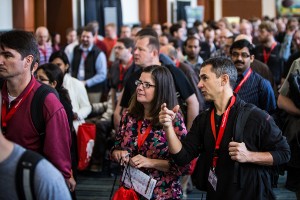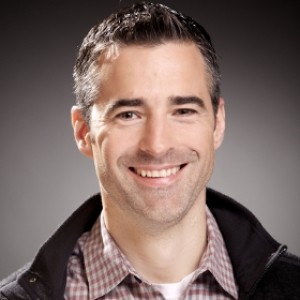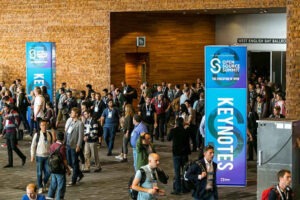There was absolutely nothing wrong with this year’s All Things Open conference. There were a few glitches, as might be expected, but not enough to matter. Was it perfect? Probably not. Perfection at a conference would probably be pretty boring — and boring would be a fault keeping it from being perfect, if you’ll excuse a little circular logic. Let’s just say say that ATO was more than good enough — and then a lot more.
But now it’s over, one for the record books, as they say, leaving behind memories and anticipation for 2015.

I saw this last year at ATO, which is about the only opportunity I have to rub elbows with big tech. This year, I no longer raised an eyebrow when I saw good things going on and positive energy being generated by the development teams at companies with worrisome business practices. I figure this is a good thing. The suits need to be surrounded by FOSS folks. Maybe a little of that “share and share alike” philosophy will rub off.
Take Facebook, for example. There’s more going on with the social giant besides Zuckerberg and his friends being busy turning data mining into profits.

It seems that the company is committed to open sourcing practically everything it creates, from hardware to software. I knew about the company’s open sourcing of green hardware through the Open Compute Project, but I’d assumed the company was like many other firms, given its track record on privacy issues — happy to build infrastructures on open source and give nothing back.
Not true, according to Pearce.
“There are companies I know that claim to do open source,” he said, “but when you look at their projects they are somewhat into vanity projects, little things that are thrown out there. What we open source is the infrastructure that we actually use. When Wikipedia uses HHVM, our web server, it is exactly the same code that we use. When other companies are using WebScaleSQL, that’s exactly the version of MySQL that we’re using. When people are using React, whether it’s the Khan Academy or GitHub, that’s the same version of the React library that we’re using.”
Who knew? Maybe you did, but I surely didn’t. Of course, I don’t spend a lot of time on GitHub.
Most of Pearce’s time at the podium was spent talking about the efforts being taken by him and his team to manage Facebook’s portfolio of open source code — all of which eventually ends up under community control. His words could be used as a primer for other companies that might get wise and decide to open source their code base. After all, if a giant such as Facebook finds it beneficial to give its code away, shouldn’t that mean something? I’ll be writing more on this in the upcoming weeks.
Pearce was followed by DeLisa Alexander, who spoke about Thursday’s issue du jour at ATO: Women in Open Source. During the noon hour, Alexander also moderated a panel discussion on the same topic, which consisted of six women professionals who hold important positions in the open source community. In her keynote, she pointed out that diversity is important not only because it’s fair and just, but for more mundane, some might say practical, reasons as well. It turns out that the tech industry needs women and minorities.
“We cannot find enough qualified people to do the important jobs that we have to do to solve our customers’ problems,” she explained. “… Half the world’s population is female, and in the U.S. workforce, 47 percent are female. Then you look at computing jobs and only 25 percent of those jobs are held by women. That’s really reducing the workforce that we can try to attract. It gets more depressing from there. If you look at the number of people who are entering degree fields for computer science and information science that are female, it’s twelve percent….

These numbers are also in sharp contrast to figures from the early to mid 1980s, when something like 37 percent of those seeking computer science degrees were women.
At ATO, I had the chance to talk with Julia Elman with the Raliegh/Durham, North Carolina chapter of Girl Develop It and Erica Stanley with the Atlanta chapter of Women Who Code — so there’ll be much more on this issue coming up on FOSS Force in the next week or so.
Immediately following the morning keynote, I made sure to attend the session led by Daniel Abadie, CTO for the Buenos Aires City Government, who talked about the work being done to bring openness to the city’s web presence. Among other things, he and his team have been writing a lot of code, which they are making available to other municipalities, and have also been making all of the data the city collects freely available to residents. There’s much more — the work being done there is simply amazing.
In the weeks before the conference, Abadie and I played email tag in an attempt to schedule an interview, which evidently wasn’t meant to be. However, an interview is still on tap, so we’ll have more on this very positive story in the near future.
On Thursday afternoon, I was able to catch a very informative session on design conducted by Erin Richey with Known, an open publishing / community platform project. We’re currently in the process of making plans to attempt an install of Known on our server for testing purposes, and we’ll be sure to write something about that.
The interview I didn’t get, but should have, was with Charlie Reisinger who talked about the work being done to get laptops loaded with Linux in the hands of students in the Penn Manor School District in Pennsylvania. Luckily, I was able to get acquainted with Reisinger, who’s very personable and easygoing, so I don’t anticipate that we’ll have any difficulty getting him to talk with us. In other words, I’m hoping we’ll have the opportunity to bring you more in-depth coverage about this as well.
Looking ahead to All Things Open for 2015: Executive chairperson Todd Lewis announced that beginning next year the conference will shift from mid week to the beginning of the week, with things getting started on a Sunday and most of the conference taking place on Monday and Tuesday. We can also expect there will be more tweaking of the content, as Lewis and the folks at IT-oLogy work to make the conference even more relevant. One thing we can expect are more sessions for those who use or work with open source outside the enterprise.
Christine Hall has been a journalist since 1971. In 2001, she began writing a weekly consumer computer column and started covering Linux and FOSS in 2002 after making the switch to GNU/Linux. Follow her on Twitter: @BrideOfLinux








